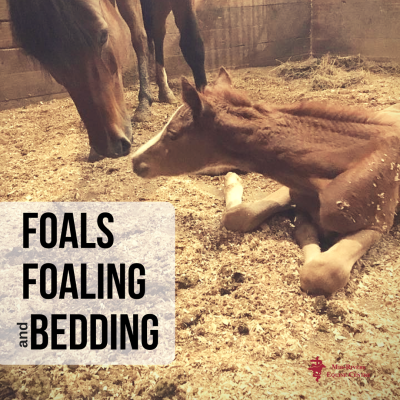It  appears there is some confusion amongst our Facebook family on the stall bedding in preparation for foaling. As there is more than one way to shoe a horse, there are many ways to bed a stall in preparation for foaling. The key is in understanding the “why” not the “what”.
appears there is some confusion amongst our Facebook family on the stall bedding in preparation for foaling. As there is more than one way to shoe a horse, there are many ways to bed a stall in preparation for foaling. The key is in understanding the “why” not the “what”.
So why use straw? Let us explain:
Protects The Health Of The Mother
Straw is a time-tested bedding but it is a tradition more than it is the best way. Straw is widely used for foaling and the reason we foal on straw is because shavings are often dusty and are more abrasive should they be inadvertently pulled into the mare’s reproductive tract. During foaling, it is not uncommon for the foal’s legs to emerge only to retract back into the birth canal as the contraction subsides. Shavings stuck on the foal or more specifically the amnion are then introduced into the mare and again, in our opinion are more abrasive than straw.
It is often believed that straw is used as a benefit to the foal, when it is actually used to protect the mother. In fact, straw bedding because it’s less absorbent makes it more difficult for a foal to stand for the first time. The difficulty is compounded on mats bedded with straw as they become wet and slippery. This is why we recommend transitioning to pine shavings as soon as the birth process is complete.
The typical concerns of inhaling dust, getting shavings in their eyes, or eating the shavings are no different than the health concerns we have for all horses on shavings. Over the years there have been concerns for a specific bacterium known as Klebsiella being a risk to the foal. This bacterium is more likely found in oak shavings. Regardless of what bedding is used, normal sanitary practices will help your foal stay healthy. Therefore, as soon as foaling is complete it is safe to remove straw bedding and lay down pine shavings.
Healthy Foal Checklist
So, if shavings aren’t a major concern what should we concern ourselves with? One of the most important things you can do before the baby is born is to follow a pregnant mare care program with your veterinarian. After the foal is born, take these steps to protect the health of your foal:
1.Make sure to pay close attention to cleanliness and remove soiled bedding immediately.
2.Treat the navel with antiseptic to prevent infectious contamination.
3.Insure rapid (if not immediate) ingestion of colostrum.
4.If the foaling went normally, as outlined in the 1-2-3 rule (https://www.midriversequine.com/foaling-the-1-2-3-rule/), have the foal evaluated the next day by your veterinarian to confirmed good colostrum antibody transfer.
5.Follow the recommended vaccination and exam schedule for the first year.
Take Away Message
The reason we use straw to bed foaling stalls is to protect the mare. What a foal’s stall is bedded with is much less important to its health than following the guidelines in the Healthy Foal Checklist. As with everything, understanding the “why” allows us to adapt and still produce a good outcome for both mare and foal.